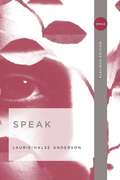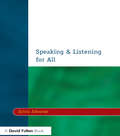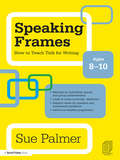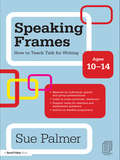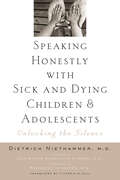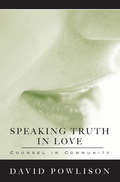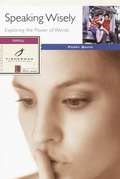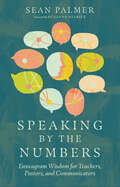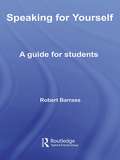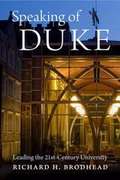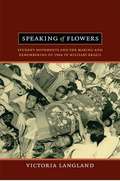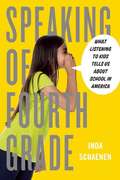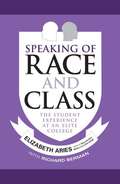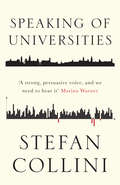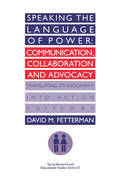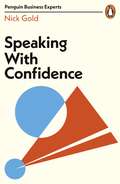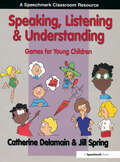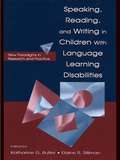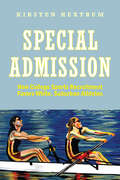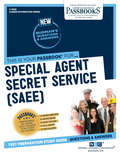- Table View
- List View
Speak: Platinum Edition
by Laurie Halse AndersonThis special anniversary edition of Anderson's National Book Award-winning novel includes an new Introduction and Afterword by the author, including an interview about her writing practices. Note: Ads for this edition named other end material including a discussion guide and preview of her next book, but the material was not present in the print edition.
Speakers' Club: Public Speaking for Young People (Grades 4-8)
by Barbara JuskowThe ability to give an effective verbal presentation is an important skill that you can teach your students. To be able to give strong, organized oral presentations increases a person's chances of being regarded as knowledgeable, capable, and in command. This complete, developmental program prepares young people to become confident public speakers. It introduces techniques for writing and delivering interesting, animated speeches. General topics include making introductions, quick-pick speeches, writing a speech, and speaking techniques.Fashioned after Toastmasters, the program includes complete lesson plans, worksheets and information sheets, and evaluation forms. The culminating activity is a program that allows each participant to make an oral presentation. In each lesson, practical ideas introduce and reinforce the need for preparation and attention to detail. The series of lessons begins with fun, low-anxiety activities and ends with a presentation for parents.Once students become skillful and confident in public speaking, you will find many opportunities for them to use these skills. There are opportunities for oral presentations in all areas of the curriculum. Some activities that would reinforce public speaking skills are oral book reports, reader's theater, discussion groups, oral reports in content areas, poster talks, interviews, demonstrations or explanations of how to do something, brainstorming, debates, plays, teaching a lesson, dramatic or expressive reading, or role-playing.For more guidance on verbal presentation, see Public Speaking: A Student Guide to Writing and Delivering a Great Speech.Grades 4-8
Speaking & Listening for All (Entitlement For All Ser.)
by Sylvia EdwardsFirst Published in 1999. Routledge is an imprint of Taylor & Francis, an informa company.
Speaking English as a Second Language: Learners' Problems and Coping Strategies
by Alireza JamshidnejadThis book focuses on understanding the process of problem construction in oral communication in foreign language contexts, examining how speakers of English as a second language approach issues in oral communication, as well as the strategies they employ to overcome these difficulties. Using theories of general communication, and in particular current approaches to L2 oral communication and strategies in interactional discourse, the authors construct a theoretical framework for defining, identifying and classifying learners’ problems and coping strategies when speaking English as a second or foreign language. The book offers a coherent process-oriented description of the complex and multidimensional nature and typology of oral interaction problems in EFL contexts, and it will be of interest to practitioners, teachers, researchers, students, and curriculum designers in Applied Linguistics and TESOL.
Speaking Frames: How To Teach Talk For Writing
by Sue PalmerNow in a new format Speaking Frames: How to Teaching Talk for Writing: Ages 8-10 brings together material from Sue Palmer’s popular Speaking Frames books for years 3 and 4. Providing an innovative and effective answer to the problem of teaching speaking and listening, this book offers a range of speaking frames for children to orally ‘fill in’ developing their language patterns and creativity, and boosting their confidence in talk for learning and talk for writing. Fully updated, this book offers: material for individual, paired and group presentations links to cross-curricular ‘Skeletons’ support notes for teachers and assessment guidance advice on flexible progression and working to a child’s ability suggestions for developing individual pupils' spoken language skills. With a wealth of photocopiable sheets and creative ideas for speaking and listening, Speaking Frames: How to Teaching Talk for Writing: Ages 8-10 is essential reading for all practising, trainee and recently qualified teachers who wish to develop effective speaking and listening in their classroom.
Speaking Frames: How To Teach Talk For Writing - Ages 10-14
by Sue PalmerNow revised and expanded Speaking Frames: How to Teaching Talk for Writing: Ages 10-14 brings together material from Sue Palmer’s popular Speaking Frames books with additional material covering the primary/secondary transition. Providing an innovative and effective answer to the problem of teaching speaking and listening, this book offers a range of speaking frames for children to orally ‘fill in’, developing their language patterns and creativity, 'and boosting their confidence in the use of literate language patterns. Fully updated, this book offers: material for individual paired and group presentations and talk for writing links to cross-curricular ‘Skeletons' transition material and guidance on ‘bridging the gap’ between primary and secondary schools support notes for teachers and assessment guidance advice on flexible progression and working to a child’s ability suggestions for developing individual pupils' spoken language skills. With a wealth of photocopiable sheets and creative ideas for speaking and listening, Speaking Frames: How to Teaching Talk for Writing: Ages 10-14 is essential reading for all practising, trainee and recently qualified teachers who wish to develop effective speaking and listening in their classroom.
Speaking Honestly with Sick and Dying Children and Adolescents: Unlocking the Silence
by Dietrich NiethammerTalking openly with sick and dying children about their illness is always difficult and often agonizing. It is honesty, however, that these children deserve and need. Dietrich Niethammer, a prominent pediatric oncologist, explains why it is so important to speak frankly and respectfully to young patients about their disease.The question at the heart of this book is how children and adolescents feel and think about death and dying. Dr. Niethammer thoroughly examines the literature on the topic, arguing that children and adolescents not only are capable of discussing their illness but benefit from doing so. Puzzled why it took medical practitioners so long to accept truth-telling in their care of dying children, Niethammer traces the development of this notion from the early twentieth-century work of Sigmund Freud to the discomfort surrounding it still today.Severely sick children and adolescents think about the consequences of their disease, whether adults discuss it with them or not. When adults remain silent, they do a disservice to the children. Dr. Niethammer urges doctors to practice not in silence and denial but in open communication with ill children, giving the children an opportunity to express their fears and anxieties and to cope with their disease on their own terms.Dr. Niethammer's compelling personal experiences combined with the latest research make this a compassionate and invaluable resource for physicians, nurses, social workers, teachers, parents—for all who care for sick and dying children and adolescents.
Speaking Truth in Love: Counsel in Community (Vantage Point Book Ser.)
by David PowlisonYou probably speak 20,000 words a day, give or take, and each one influences those who listen. No wonder God has so much to say about our words. We are all counselors, whether we realize it or not!Speaking Truth in Love is a blueprint for communication that strengthens community in Christ. The principles outlined in this pivotal work are specific to counseling, yet extend to marriage, family, friendship, business, and the church. Have you ever wondered how to be a more effective counselor? Have you ever looked for a better way to talk to difficult people? Have you ever wanted to express faith and love more naturally in your relationships?Practical in its approach yet comprehensive in its scope, Speaking Truth in Love is sure to become required reading for anyone interested in pursuing a career as a counselor or anyone else who longs for ways to redeem relationships.
Speaking Wisely: Exploring the Power of Words (Fisherman Bible Studyguide Series)
by Poppy SmithReaders will learn how to help others by cultivating the habit of using words that encourage, express love, and praise God.From the Trade Paperback edition.
Speaking and Listening through Drama 7-11
by Nigel Toye Mr Francis Prendiville'This book is special. It proposes a style of drama that liberates teachers and children from traditional dialogues...The dramas, each linked to a literacy text or wider theme, are amazing...I would recommend buying this. It challenges, but rewards with a new level of classroom dialogue' - Literacy Time 'This new book for teachers is timely and full of good ideas. It demonstrates the value of drama as a means of achieving education that stimulates creative and critical thinking while also engaging the emotions' - Teaching Thinking & Creativity Showing teachers how to use drama to promote speaking and listening for pupils, including those who find learning difficult, this book describes, analyses and teaches how to use role play effectively and looks at how to generate a productive dialogue between teachers and pupils that is both powerful and enabling. The authors present innovative methods for teaching across the curriculum which are genuinely inclusive and can help to motivate reluctant learners. The 'how to' section of the book describes a range of strategies and approaches: o how to begin with 'teacher in role' o how to begin planning drama o how to generate quality speaking and listening o how to use drama for inclusion and citizenship o how to generate empathy in drama o how to link history and drama o how to begin using assessment of speaking and listening (and other English skills) through drama The second section includes full lesson plans that have been tried and tested with pupils, complete with detailed guidance on how to structure the work and how to play the teacher roles. Each is linked to literacy, the wider curriculum, PSHE and citizenship. The book is a valuable resource for primary teachers in training and in practice.
Speaking by the Numbers: Enneagram Wisdom for Teachers, Pastors, and Communicators
by Sean PalmerIt's not just what you say, but how you say it.Speaking by the Numbers
Speaking for Yourself: A Guide for Students
by Robert BarrassAs a student, and in any profession based on your studies, you need good oral communication skills. It is therefore extremely important to develop your ability to converse, to discuss, to argue persuasively, and to speak in public. Speaking for Yourself provides clear, straightforward advice that will help you: be a good listener express yourself clearly and persuasively contribute effectively to discussions prepare talks or presentations prepare effective visual aids deliver effective presentations perform well in interviews. In short, it will help you to express your thoughts clearly and persuasively – helping to achieve your short and medium-term goals as a student and your career goals.
Speaking of Duke: Leading the Twenty-First-Century University
by Richard H. BrodheadOver the course of his thirteen years as president of Duke University, Richard H. Brodhead spoke at numerous university ceremonies, community forums, and faculty meetings, and even appeared on The Colbert Report. Speaking of Duke collects dozens of these speeches, in which Brodhead speaks both to the special character and history of Duke University and to the general state of higher education. In these essays, Brodhead shows a university thinking its way forward through challenges all institutes of higher education have faced in the twenty-first century, including an expanding global horizon, an economic downturn that has left a diminished sense of opportunity and a shaken faith in the value of liberal arts education, and pressure to think more deeply about issues of equity and inclusion. His audiences range from newly arrived freshmen and new graduates—both facing uncertainty about how to build their future lives—to seasoned faculty members. On other occasions, he makes the case to the general public for the enduring importance of the humanities. What results is a portrait of Duke University in its modern chapter and the social and political climate that it shapes and is shaped by. While these speeches were given on official occasions, they are not impersonal official pronouncements; they are often quite personal and written with grace, humor, and an unwavering belief in the power of education to shape a changing world for the better. Brodhead notes that it is an underappreciated fact that a great deal of the exercise of power by a university leader is done through speaking: by articulating the aspirations of the school and the reasons for its choices, and by voicing the shared sense of mission that gives a learning community its reality. Speaking of Duke accomplishes each of those and demonstrates Brodhead's conviction that higher education is more valuable now than ever.
Speaking of Flowers: Student Movements and the Making and Remembering of 1968 in Military Brazil
by Victoria LanglandSpeaking of Flowers is an innovative study of student activism during Brazil's military dictatorship (1964-85) and an examination of the very notion of student activism, which changed dramatically in response to the student protests of 1968. Looking into what made students engage in national political affairs as students, rather than through other means, Victoria Langland traces a gradual, uneven shift in how they constructed, defended, and redefined their right to political participation, from emphasizing class, race, and gender privileges to organizing around other institutional and symbolic forms of political authority. Embodying Cold War political and gendered tensions, Brazil's increasingly violent military government mounted fierce challenges to student political activity just as students were beginning to see themselves as representing an otherwise demobilized civil society. By challenging the students' political legitimacy at a pivotal moment, the dictatorship helped to ignite the student protests that exploded in 1968. In her attentive exploration of the years after 1968, Langland analyzes what the demonstrations of that year meant to later generations of Brazilian students, revealing how student activists mobilized collective memories in their subsequent political struggles.
Speaking of Fourth Grade
by Inda SchaenenFourth grade is ground zero in the fierce debates about education reform in America. It's when kids (well, some of them) make the shift from "learning to read" to "reading to learn," and tomes have been written about the fourth-grade year by educators, administrators, philosophers, and pundits. Now, in a fascinating and groundbreaking book, Inda Schaenen adds the voices of actual fourth-grade kids to the conversation.Schaenen, a journalist turned educator, spent a year traveling across the state of Missouri, the geographical and spiritual center of the country, visiting fourth-grade classrooms of every description: public, private, urban, rural, religious, charter. Speaking of Fourth Grade looks at how our different approaches to education stack up against one another and chronicles what kids at the heart of our great, democratic education experiment have to say about "What Makes a Good Teacher" and "What Makes a Good Student," as well as what they think about the Accelerated Reader programs that dominate public school classrooms, high-stakes testing, and the very purpose of school in the first place.A brilliant and original work at the intersection of oral history, sociology, and journalism, Speaking of Fourth Grade offers unique insight into the personal consequences of national education policy. The voices of the children in Speaking of Fourth Grade will stay with readers-parents, teachers, and others-for many years to come.
Speaking of Race and Class: The Student Experience at an Elite College
by Elizabeth Aries Richard BermanIn Speaking of Race and Class, the follow up volume to her groundbreaking Race and Class Matters at an Elite College, Elizabeth Aries completes her four-year study of diversity at a prestigious liberal arts college. Here, the 58 students - affluent, lower-income, black and white - that Aries has interviewed since they were Amherst freshmen, provide a complete picture of what and how each group learned about issues of race and class. Aries presents the students' personal perceptions of their experiences. She reveals what the extent to which learning from diversity takes place on campus, and examines the distinct challenges that arise for students living in this heterogeneous community. Aries also looks more broadly at how colleges and universities across the country are addressing the challenges surrounding diversity. Speaking of Race and Class testifies to the programming and practices that have proven to be successful.
Speaking of Universities
by Stefan ColliniA devastating analysis of what is happening to our universitiesDoes “marketization” threaten to destroy what we most value about education? Will this new era of “accountability” distort what it purports to measure? What do we mean by a “public” system of higher education and how should we defend it? Globalization has transformed the economic horizon. At the same time governments have systematically imposed new regulations for funding, governance, and assessment. Increasingly, universities behave more like business enterprises in a commercial marketplace than centers of learning. In recent decades there has been an immense global surge in the number of universities and the size of the student population. Technology has created new ways of learning and teaching.In Speaking of Universities, historian and critic Stefan Collini analyses these changes and challenges the assumptions of policymakers and commentators. This is an urgent call to “focus on what is actually happening and the clichés behind which it hides; an incitement to think again, think more clearly, and then to press for something better.”
Speaking the language of power: Communication, collaboration and advocacy (translating ethnology into action)
by David M. FettermanFirst Published in 1993. Routledge is an imprint of Taylor & Francis, an informa company.
Speaking with Confidence (Penguin Business Experts Series)
by Nick GoldDoes the thought of delivering a presentation make your heart skip a beat? Do your pitches fall flat no matter how much preparation you put in? Are you often comparing yourself to more eloquent speakers and wondering how they capture the room?At some point in our careers we will need to speak in front of an audience; whether to present our ideas to a group of five in a meeting, pitch for investment in front of a panel or deliver a keynote speech to one thousand delegates. Yet glossophobia, or the fear of public speaking, is incredibly common and can inhibit our chances of career progression by up to 15%. In Speaking with Confidence, Expert and managing director of Speakers' Corner Nick Gold, shows how anyone can learn to be a confident public speaker and use their surroundings to give them the support and structure they need to achieve maximum impact and success from their speech. His decades of experience coaching and producing some of the best speakers in the country have been condensed here into one expert guide to help you connect with your audience every time.
Speaking, Listening and Drama
by Andy Kempe Jan HolroydWritten for practicing and trainee English and Drama specialists, this text clarifies what constitutes useful knowledge about spoken English and how pupils aged 11-16 can develop their skills in speaking and listening through the use of drama.
Speaking, Listening and Understanding: Games and Activities for 5-7 year olds (The Good Communication Pathway)
by Catherine Delamain Jill SpringSpeaking, Listening and Understanding is a practical resource packed full of games to improve young children’s communication skills. The second edition of this bestselling resource contains a programme of games and activities to foster the speaking, listening and understanding skills of children aged from 5 to 7 years. The book seeks to address language and communication difficulties for primary-aged children by providing a range of fun and engaging activities. Suitable for whole classes or small groups of children, the activities focus on both understanding and using language in areas such as following instructions, thinking skills, inference, describing, narrating and playing with words. Features include: 160 games and activities which are differentiated by stages and levels of ability; A clear aim, equipment list and instructions for each activity; Photocopiable templates for ease of use; Supplementary resource sheets including pictures and scripts to use with the activities. Now fully revised and updated in line with current policy and legislation, this book is suitable for young children in any school setting. It also includes material that may be used as an effective part of a speech and language therapy programme in consultation with a therapist. This is a unique manual that will be an essential addition to the materials used by professionals working with young children.
Speaking, Listening and Understanding: Games for Young Children (The\good Communication Pathway Ser.)
by Catherine Delamain Jill SpringWritten by two experienced speech language therapists, who have worked extensively alongside mainstream teachers, this book provides activities that are both teacher and child friendly. It contains a collection of graded games and activities designed to foster the speaking, listening and understanding skills of children aged from 5 to 7. The activities are divided into two main areas: Understanding Spoken Language: Following Instructions; Getting the Main Idea; Thinking Skills; Developing Vocabulary; Understanding Inference. Using Spoken Language: Narrating; Describing; Explaining; Predicting; Playing with Words. Each activity has a clear aim, simple instructions, and requires minimal equipment. Activities may be carried out by teachers, classroom assistants or volunteers. Incorporates user-friendly opportunities for assessment, target setting and evaluation. Includes photocopiable material to support the activities. "Many of the activities can be used by speech language therapists, and the book can be used as an effective part of a speech and language programme. Promotes the skills outlined in Speaking and Listening in the English National Curriculum Key Stage One.
Speaking, Reading, and Writing in Children With Language Learning Disabilities: New Paradigms in Research and Practice
by Elaine R. Silliman Katharine G. ButlerThe ability to use language in more literate ways has always been a central outcome of education. Today, however, "being literate" requires more than functional literacy, the recognition of printed words as meaningful. It requires the knowledge of how to use language as a tool for analyzing, synthesizing, and integrating what is heard or read in order to arrive at new interpretations. Specialists in education, cognitive psychology, learning disabilities, communication sciences and disorders, and other fields have studied the language learning problems of school age children from their own perspectives. All have tended to emphasize either the oral language component or phonemic awareness. The major influence of phonemic awareness on learning to read and spell is well-researched, but it is not the only relevant focus for efforts in intervention and instruction. An issue is that applications are usually the products of a single discipline or profession, and few integrate an understanding of phonemic awareness with an understanding of the ways in which oral language comprehension and expression support reading, writing, and spelling. Thus, what we have learned about language remains disconnected from what we have learned about literacy; interrelationships between language and literacy are not appreciated; and educational services for students with language and learning disabilities are fragmented as a result. This unique book, a multidisciplinary collaboration, bridges research, practice, and the development of new technologies. It offers the first comprehensive and integrated overview of the multiple factors involved in language learning from late preschool through post high school that must be considered if problems are to be effectively addressed. Practitioners, researchers, and students professionally concerned with these problems will find the book an invaluable resource.
Special Admission: How College Sports Recruitment Favors White Suburban Athletes (The American Campus)
by Kirsten HextrumSpecial Admission contradicts the national belief that college sports provide upward mobility opportunities. Kirsten Hextrum documents how white middle-class youth become overrepresented on college teams. Her institutional ethnography of one elite athletic and academic institution includes over 100 hours of interviews with college rowers and track & field athletes. She charts the historic and contemporary relationships between colleges, athletics, and white middle-class communities that ensure white suburban youth are advantaged in special athletic admissions. Suburban youth start ahead in college admissions because athletic merit—the competencies desired by university recruiters—requires access to vast familial, communal, and economic resources, all of which are concentrated in their neighborhoods. Their advantages increase as youth, parents, and coaches strategically invest in and engineer novel opportunities to maintain their race and class status. Thus, college sports allow white, middle-class athletes to accelerate their racial and economic advantages through admission to elite universities.
Special Agent, Secret Service: Passbooks Study Guide (Career Examination Series)
by National Learning CorporationThe Special Agent, Secret Service (SAEE) Passbook® prepares you for your test by allowing you to take practice exams in the subjects you need to study. It provides hundreds of questions and answers in the areas that will likely be covered on your upcoming exam, including but not limited to: logic based reasoning; language use; detailed observation; evaluating conclusions in light of known facts; experience inventory; memorization; and more.
